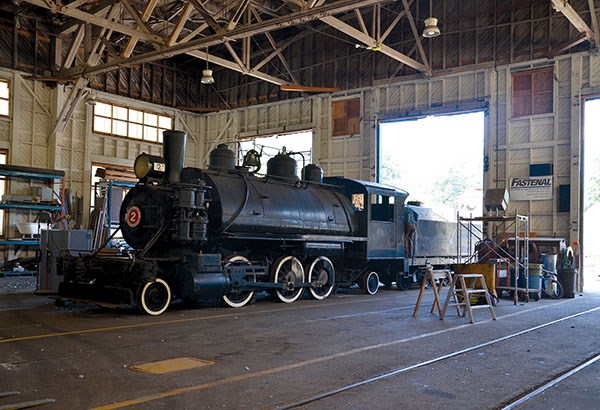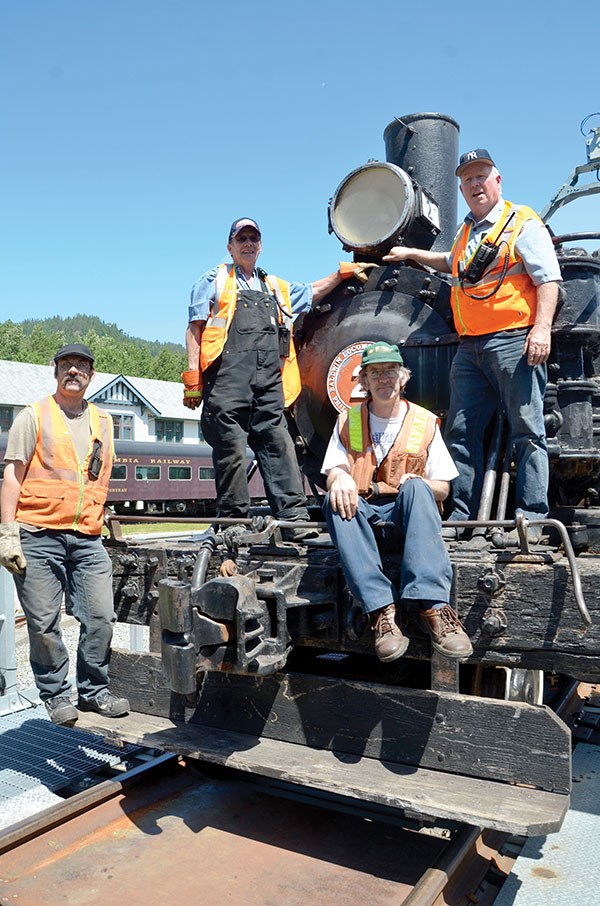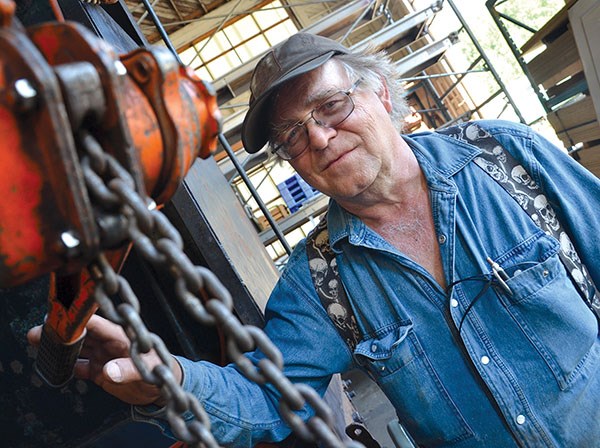The table in the small lunchroom of the old wooden car shop is laden with coffee mugs and a deep dish of gooey cinnamon buns. Oil-stained jackets hang heavily on a coat stand like snow clinging to a young cedar.
“It was rusted right out,” John Jellis says, as the conversation flows along with the java.
Underneath the table, a squirmy border collie sighs. Sky settles down on the floor as though she’s heard this conversation before; patiently waiting for the activity to start.
On Mondays the small, yellow-painted room fills with chatter. It’s the same every week — coffee, updates and then the dedicated team of 14 rolls up its sleeves.
The dirty work happens next door, under the lofty wooden beams of the 100-year-old rail car shop. The tasks take a good part of the morning, often lasting into the afternoon; hours of grinding, welding and chipping away at corrosion. It’s tedious, noisy and painstaking; as the need for additional TLC is continually uncovered. But no matter how frustrating the tasks get, the self-proclaimed “Monday Crew” keeps coming back for more.
The common thread weaving together the ex-engineers, retired B.C. Rail employees and history buffs stands amid parked carriages in the West Coast Railway Heritage Park’s shop — The Two Spot.
The small black steam engine is unassuming. The locomotive doesn’t immediately command the same attention as does the regal Royal Hudson, but don’t let her size fool you.
The Two Spot was the second train to arrive in Squamish, Trevor Mills, an archivist with the West Coast Railway Association, says as he pushes up his cap. More than a century ago, the engine helped build the railway from the foot of Howe Sound to the Cheakamus Canyon. Up and down the corridor the engine chugged, each time laying down the foundations that shaped this community.
“That railway turned us [Squamish] from farmers into industrial loggers,” Mills says.
The locomotive was built in 1910 by Baldwin Locomotives Works of Philadelphia, Pa. Until 1956 the company was one of the largest locomotive builders in North America, but lost its competitive edge when diesel engines finally took over the rails. By 1972, the company folded.
The Two Spot’s story outlasts that of Baldwin. In the 1920s, the steam engine was sold to Comox Logging on Vancouver Island. There, the locomotive was refitted with forestry equipment and made the steep, slow, switchbacks up mountains to the logging operations. She became one of the last steam engines used in forestry in B.C., continuing to haul timber until the mid ’60s.
Having lugged her last load, in 1966 the train was donated to the District of Squamish by Comox Logging. A year later the engine was placed in what’s now the O’Siyam Pavilion Park as a part of Canada’s centennial celebrations.
There she stood for 24 years. Two Spot weathered the snow, Squamish’s relentlessly wet winters and its intense summer winds. By the time the engine came into the care of the West Coast Railway Heritage Park in 1991, the locomotive’s wheels and cylinders had seized. She was, as Mike Lloyd affectionately calls her, a “rust bucket.”

“It was just sitting on a piece of track and could not be moved,” the retired B.C. Railway supervisor of the locomotive rebuild centre says as he points to the engine’s tender. “This was rusted right through.”
Lloyd’s love of the railway dates back to his childhood in England. During the Second World War, he and his mother dodged bombers by riding trains, he jokes.
“It was one of the only ways my mum could keep me quiet.”
With B.C. Rail, he spent his working days on many of the engines that are on display in the museum.
“Each locomotive has its own personality, even on the diesels,” he says.
Steam engines were loud and hot — very hot. The boiler had 160 pounds of steam in it, with temperatures reaching up to 350 degrees Fahrenheit.
“They usually had a little shelf you could put a coffee pot on,” Lloyd says.
Although it will take a lot of elbow grease and cash to get Two Spot back on the track, it was time to breathe some life into her, the instigator of the restoration project says. When he went looking for help, it didn’t take long before he had a team.
Jellis is a regular at the park. Last January, Jellis had his 15 minutes of fame when he handed over an engine’s controls to CBC television host Rick Mercer.
Jellis has always been intrigued by trains, but he never thought he would enter the railway business. On a chance, he interviewed with B.C. Rail and never looked back. Jellis held a gamut of positions, from engineer to conductor. Today, he assists BCIT railway students who visit the park as part of their training.
Unlike a lot of the men on the volunteer team, Mills never worked on the railway. The long-time Squamish resident collects information on all the museum’s artifacts, right down to the type of font used for the engine’s numbering.
“There isn’t too much I haven’t been able to find,” Mills says, as he pores over a map he’s creating as a guide to the locations of the museum’s 80 showpieces.
Mills knows the story behind each one of them, but his connection to the railway runs deeper than dates and tidbits. It’s a way for him to learn more about a father taken from him when he was only nine years old.
“I feel he is here when I am working around this stuff,” Mills says. “I remembered a little bit about him and these guys have helped fill in the stories.”
His father, Bert, was a railroader who died from a heart attack. He ran five of the engines Mills has since helped to maintain, including the Royal Hudson.
The team members share a deep respect for the history of the machines that carried much of the weight of the nation. They donate hundreds of hours keeping it alive for budding railway enthusiasts to enjoy, visiting the museum with their Thomas the Tank Engine toys in hand. The work seems never-ending and thanks to the dedication of Squamish residents like Donna Fourchalk, who tirelessly fundraises for the various projects, the tasks are kept on track.
Besides Two Spot, the volunteers have also begun restoration on the train’s tender. They’re a combo — one with the engine, the other with the thousands of gallons of water and coal needed to power it. The project’s end date changes depending on who you ask, alternating between “oh, I don’t know,” to six months to a year.
“When you start a project, you have to stay with it. I don’t like to say [when it will be complete] because we keep getting surprised,” Lloyd says, pointing out today’s discovery of further rust damage in the cabin’s roof. “You just never know.”




